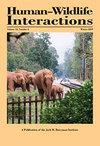Role of farmer knowledge in agro-ecosystem science: Rice farming and amphibians in the Philippines
IF 0.9
4区 环境科学与生态学
Q4 BIODIVERSITY CONSERVATION
引用次数: 8
Abstract
Rice (Oryza sativa) agriculture provides food and economic security for nearly half of the world’s population. Rice agriculture is intensive in both land and agrochemical use. However, rice fields also provide aquatic resources for wildlife, including amphibians. In turn, some species may provide ecosystem services back to the farmers working in the rice agroecosystem. The foundation for understanding the complexity of agroecosystem–human relationships requires garnering information regarding human perceptions and knowledge of the role of biodiversity in these rice agroecosystems. Understanding farmer knowledge and perceptions of the ecosystem services provided by wildlife in their fields, along with their understanding of the risks to wildlife associated with agrochemical exposure, can inform biodiversity preservation efforts. In June and July 2014, we used focus groups and structured and semi-structured interviews that engaged 22 individuals involved in rice agriculture operations in Laguna, Philippines, a village close to the International Rice Research Institute in Los Baños, Philippines, to learn more about farmer perceptions and knowledge of amphibians in their rice fields. We found that many, though not all farm workers (managers, tenants, and laborers) noted declines in amphibian populations over time, expressed how they incorporated frogs and toads (Anura) into their daily lives, and recognized the value of amphibians as ecosystem service providers. Specifically, farmers noted that amphibians provide pest-management through consumption of rice pests, act as biomonitors for pesticiderelated health outcomes, and provide a local food and economic resource. Some farmers and farm workers noted the general cultural value of listening to the “frogs sing when it rains.” Overall, our findings demonstrate that farmers have an understanding of the value of amphibians in their fields. Future efforts can support how engagement with farmers and farm workers to evaluate the value of wildlife in their fields can lead to directed education efforts to support biodiversity conservation in agroecosystems.农民知识在农业生态系统科学中的作用:菲律宾的水稻种植和两栖动物
水稻(Oryza sativa)农业为世界上近一半的人口提供食物和经济保障。水稻农业在土地和农用化学品的使用上都很密集。然而,稻田也为包括两栖动物在内的野生动物提供了水生资源。反过来,一些物种可能为在水稻农业生态系统中工作的农民提供生态系统服务。理解农业生态系统-人类关系复杂性的基础需要收集有关人类对这些水稻农业生态系统中生物多样性作用的认知和知识的信息。了解农民的知识和对野生动物在其田地中提供的生态系统服务的认识,以及他们对与农用化学品接触相关的野生动物风险的了解,可以为生物多样性保护工作提供信息。2014年6月和7月,我们采用焦点小组和结构化和半结构化访谈的方式,在菲律宾拉古纳,一个靠近洛斯Baños国际水稻研究所的村庄,对22名从事水稻农业经营的个人进行了访谈,以了解更多农民对稻田中两栖动物的看法和知识。我们发现,尽管不是所有的农场工人(经理、租户和工人)都注意到两栖动物数量随着时间的推移而下降,他们表达了如何将青蛙和蟾蜍(无头蛙)纳入他们的日常生活,并认识到两栖动物作为生态系统服务提供者的价值。具体而言,农民指出,两栖动物通过食用水稻害虫提供虫害管理,充当农药相关健康结果的生物监测员,并为当地提供粮食和经济资源。一些农民和农场工人注意到听“下雨时青蛙唱歌”的普遍文化价值。总体而言,我们的研究结果表明,农民了解两栖动物在其田地中的价值。未来的努力可以支持农民和农场工人参与评估其领域内野生动物的价值,从而引导有针对性的教育工作,以支持农业生态系统中的生物多样性保护。
本文章由计算机程序翻译,如有差异,请以英文原文为准。
求助全文
约1分钟内获得全文
求助全文
来源期刊

Human–Wildlife Interactions
Environmental Science-Nature and Landscape Conservation
CiteScore
2.80
自引率
0.00%
发文量
0
审稿时长
11 weeks
期刊介绍:
Human–Wildlife Interactions (HWI) serves the professional needs of the wildlife biologist and manager in the arena of human–wildlife conflicts/interactions, wildlife damage management, and contemporary wildlife management. The intent of HWI is to publish original contributions on all aspects of contemporary wildlife management and human–wildlife interactions with an emphasis on scientific research and management case studies that identify and report innovative conservation strategies, technologies, tools, and partnerships that can enhance human–wildlife interactions by mitigating human–wildlife conflicts through direct and indirect management of wildlife and increased stakeholder engagement. Our intent is to promote a dialogue among wildlife professionals concerning contemporary management issues. As such, we hope to provide a repository for wildlife management science and case studies that document and share manager experiences and lessons learned.
 求助内容:
求助内容: 应助结果提醒方式:
应助结果提醒方式:


